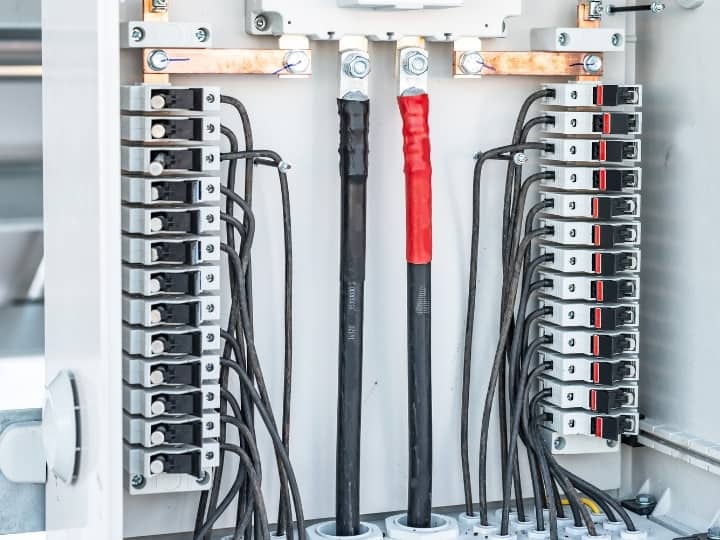A solar charge controller is engineered to govern the current and voltage to the optimal requirements to charge the battery and protect the battery from overloading. The power generated by the solar panel array must be such that efficiency losses due to cable lengths and conversion losses are minimized.
Overloading the charge controller with power from the solar array may damage the controller components, and it may lead to the melting of wires and damage to the system. Circuit breakers or fuses should be installed to prevent system damage and electrical fire.
The main function of a charge controller in an off-grid solar power system is to protect against overload; voltage disconnects and reverse currents back to the solar panels.
- Overload protection of the battery bank
- Low voltage disconnects to prevent overcharging of the battery bank
- Blocking reverse currents at low light conditions from damaging the solar array
Let’s discuss how the charge controller Amperage capacity is determined to prevent damage to the critical components of the solar system.
Also, see:

When Is A Solar Charge Controller Too Small?
The Ampere Rating of a solar charge controller must be such that it can convert the solar power generated into the optimal charge voltage currently defined by the battery manufacturer to charge the battery bank.
If the amperage rating of the charge controller is too low, the internal components and circuits will be damaged and potentially result in a fire.
The main function of the solar charge controller is to step down the voltage input from the solar array to the required charge voltage for the battery. The overload protection of the battery is the main function of the solar charge controller.
If the input voltage and current are too high for the charge controller to handle, it will cause the components and wiring inside the controller to overheat and melt.
Circuit breakers or fuses should be installed to protect the solar charge controller from damage due to overload.
In a simple solar system, a WMP type solar charge controller is selected based on the voltage output of the solar panels and the voltage input required by the battery being the same.
Larger Solar Systems
For a larger, more complex solar system with multiple solar arrays or other input power sources, dedicated MPPT type solar charge controllers are dedicated to each input source.
The size of the MPPT charge controller is determined by the degree of voltage step down required by the batteries.
As the voltage from the solar panels is reduced to the required battery charge voltage, the charge current will increase. The solar charge controller is the sacrificial component in the solar system. If the Amperage rating of the selected charge controller is too low, the controller will fail.
See also: What A Solar Charge Controller Does (Explained)
How To Determine The Correct Size Charge Controller?
The function of the solar charge controller is to:
- Charge the batteries at the optimal charge voltage and current;
- Sense the battery State Of Charge (SOC) and tapering down the charging to prevent overloading;
- Prevent reverse current flow from the batteries to the panels when the solar panels are no longer generating power
Calculating the Ampere Rating of the solar charge controller, the maximum power output of the solar panels (Watt Output) must be converted to the optimal battery charge voltage (V).
If the solar array has a maximum rated power output of 1000W and the 12V Lithium-ion battery bank requires a charge voltage of 14V, then the resultant charge current is 1000W / 14V = 71.43A.
The charge controller selected must thus have a minimum ampere rating of 90A (71.43A x 125% = 89.28A). If the ampere rating of the charge controller is below this value, the device will still limit the battery charge current to the required 14V, but the current of 71.43A will overload the copper wiring in the charge controller.
This high current will cause the wiring to overload and ultimately overheat and melt. The heat may lead to a fire causing extensive damage to the installation. The key rules to remember when calculating the size (Ampere Rating) of the solar charge controllers are:
Output Power (W) = Input Power (W)
Solar Panel has high voltage and low current (V x I) to limit voltage drop from panel installation to charge controller.
Battery requires defined charge voltage (V) at a defined charge power (W)
Charge Power (W) / Charge Voltage (V) = Charge Current (A)
Charge Controller Amperage = 125% x Charge Current (A)
Ensure that the batteries in the house bank have a maximum allowable charge current than the charge controller amperage. The price of a charge controller increases as their Amp-ratings increase by approximately 20% per 20A. It is better to have a slightly higher Amp-rated charge controller than one slightly too small.
Can A Solar Charge Controller Overload A Battery?
Solar charge controllers are designed and sized to prevent the battery from overloading, overheating, and becoming damaged. There are two types of solar charge controllers commonly used in the solar industry for off-grid systems.
PWM (Pulse Width Modulated) charge controllers are much lower in cost than MPPT charge controllers and are good for simple systems with similar voltage input and output. The PWM charge controller pulse charges the battery at the same voltage that it receives from the solar panels.
MPPT (Maximum Power Point Tracking) Charge Controllers are the most sophisticated and expensive, adding the most value to complex solar system setups. The MPPT tracks the optimum voltage/current ratio from the solar array.
MPPT controllers are ideal to step down the high voltage output from the solar array to a lower optimal charge voltage as the voltage of the power generated by the solar array is reduced, so the current (A) is increased.
Power Output Solar (Wo) = Voltage Output (Vo) x Current Output (Ao)
Battery Charge Power (Wc) = Charge Voltage (Vc) x Charge Current (Ac)
The system is designed such that:
Power Output Solar (Wo) = Battery Charge Power (Wc)
A PWM Charge Controller of the correct charge voltage (Vc) must connect the solar array and the battery bank. If the charge voltage is too high, the batteries will be overcharged and damaged.
If an MPPT controller is selected with a too low Apm-rating, it will try to limit the charge voltage (Vc) to the programmed value, but the charge controller will overheat and fail due to restricting the current flow.
References:



